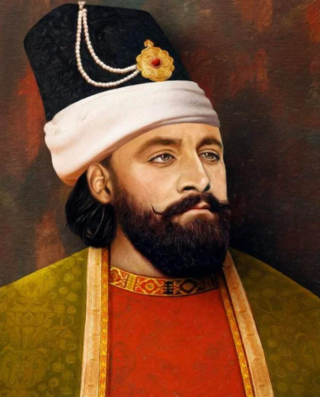
Fath-Ali Shah Qajar was the second Shah (king) of Qajar Iran. He reigned from 17 June 1797 until his death on 24 October 1834. His reign saw the irrevocable ceding of Iran's northern territories in the Caucasus, comprising what is nowadays Georgia, Dagestan, Azerbaijan, and Armenia, to the Russian Empire following the Russo-Persian Wars of 1804–1813 and 1826–1828 and the resulting treaties of Gulistan and Turkmenchay. Historian Joseph M. Upton says that he "is famous among Iranians for three things: his exceptionally long beard, his wasp-like waist, and his progeny."

The Karabakh Khanate was a khanate under Iranian and later Russian suzerainty, which controlled the historical region of Karabakh, now divided between modern-day Armenia and Azerbaijan. In terms of structure, the Karabakh Khanate was a miniature version of Iranian kingship. The administrative and literary language in Karabakh until the end of the 19th century was Persian, with Arabic being used only for religious studies, despite the fact that most of the Muslims in the region spoke a Turkic dialect.

The Baku Khanate, was a khanate under Iranian suzerainty, which controlled the city of Baku and its surroundings from 1747 to 1806.

The Ganja Khanate was a khanate under Iranian suzerainty, which controlled the town of Ganja and its surroundings, now located in present-day Azerbaijan.

The Shaki Khanate was a khanate under Iranian and later Russian suzerainty, which controlled the town of Shaki and its surroundings, now located in present-day Azerbaijan.

Shirvan Khanate was a Caucasian khanate under Iranian suzerainty, which controlled the Shirvan region from 1761 to 1820.

The Nakhichevan Khanate was a khanate under Iranian suzerainty, which controlled the city of Nakhichevan and its surroundings from 1747 to 1828.

The Erivan Khanate, also known as Chokhur-e Sa'd, was a khanate that was established in Afsharid Iran in the 18th century. It covered an area of roughly 19,500 km2, and corresponded to most of present-day central Armenia, the Iğdır Province and the Kars Province's Kağızman district in present-day Turkey and the Sharur and Sadarak districts of the Nakhchivan Autonomous Republic of present-day Azerbaijan.
Ibrahim Khalil Khan Javanshir (1732–1806) was an Azerbaijani Turkic khan of the Karabakh Khanate from the Javanshir family, who succeeded his father Panah-Ali khan Javanshir as the ruler of the khanate.

Panah Ali Khan Javanshir was the founder and first ruler of the Karabakh Khanate under Persian suzerainty.
Javad Khan Qajar was a member Ziyadoghlu Qajar, a clan of the Qajar tribe, as well as the sixth and the last khan of the Ganja Khanate from 1786 to 1804 before it was lost to Russia.

The khanates of the Caucasus, also known as the Azerbaijani khanates, Persian khanates, or Iranian khanates, were various provinces and principalities established by Persia (Iran) on their territories in the Caucasus from the late Safavid to the Qajar dynasty. The Khanates were mostly ruled by Khans of Turkic (Azerbaijani) origin and were vassals and subjects of the Iranian Shah. The khans neither had territorial or religious unity, nor an ethnic/national identity. They were mostly interested in preserving their positions and income.

Hossein Qoli Khan Qajar Sardar Iravani was an Iranian statesman and commander in Qajar Iran, who was the last khan (governor) of the Erivan Khanate from 1807 to 1828.

Iranian Armenia (1502–1828) refers to the period of Eastern Armenia during the early-modern and late-modern era when it was part of the Iranian empire. Armenians have a history of being divided since the time of the Byzantine Empire and the Sassanid Empire, in the early 5th century. While the two sides of Armenia were sometimes reunited, this became a permanent aspect of the Armenian people.

The Battle of Ganja, Siege of Ganja Fortress or Assault on Ganja was the result of a Russian offensive in the South Caucasus intended to conquer the Ganja Khanate of Qajar Iran, which contributed to the escalation of the Russo-Persian War (1804–1813).
Shahverdi Khan Ziyadoghlu was the beylerbey of Karabakh from 1740 to 1743 and first khan of Ganja from 1747 to 1760. He was from the Ziyadoglu branch of the Qajar clan who ruled the Beylerbeylik of Karabakh as hereditary governors.

Qajar Iran, also referred to as Qajar Persia, the Qajar Empire, Sublime State of Persia, officially the Sublime State of Iran and also known as the Guarded Domains of Iran, was an Iranian state ruled by the Qajar dynasty, which was of Turkic origin, specifically from the Qajar tribe, from 1789 to 1925. The Qajar family took full control of Iran in 1794, deposing Lotf 'Ali Khan, the last Shah of the Zand dynasty, and re-asserted Iranian sovereignty over large parts of the Caucasus. In 1796, Agha Mohammad Khan Qajar seized Mashhad with ease, putting an end to the Afsharid dynasty. He was formally crowned as Shah after his punitive campaign against Iran's Georgian subjects.
Mohammad Khan Qajar was the khan (governor) of the Erivan Khanate from 1784 to 1805.
Ziyadoghlu Qajar or Ziyadlu were a branch of Qajar tribe that ruled Safavid Karabakh from 1546–1554 to 1743, Astarabad in various times, Ganja Khanate from 1747 to 1805 and Iravān Khanate from 1755 to 1828. Some authors suggested that, Qovanlu branch of Qajars who ruled Iran from 1789 to 1925, which is currently better known as Qajar dynasty was a cadet-branch of Ziyadoghlu family.
Ughurlu Khan or Oghurlu Khan was a claimant to Khanate of Ganja and a member Ziyadoghlu Qajar, a clan of the Qajar tribe.














